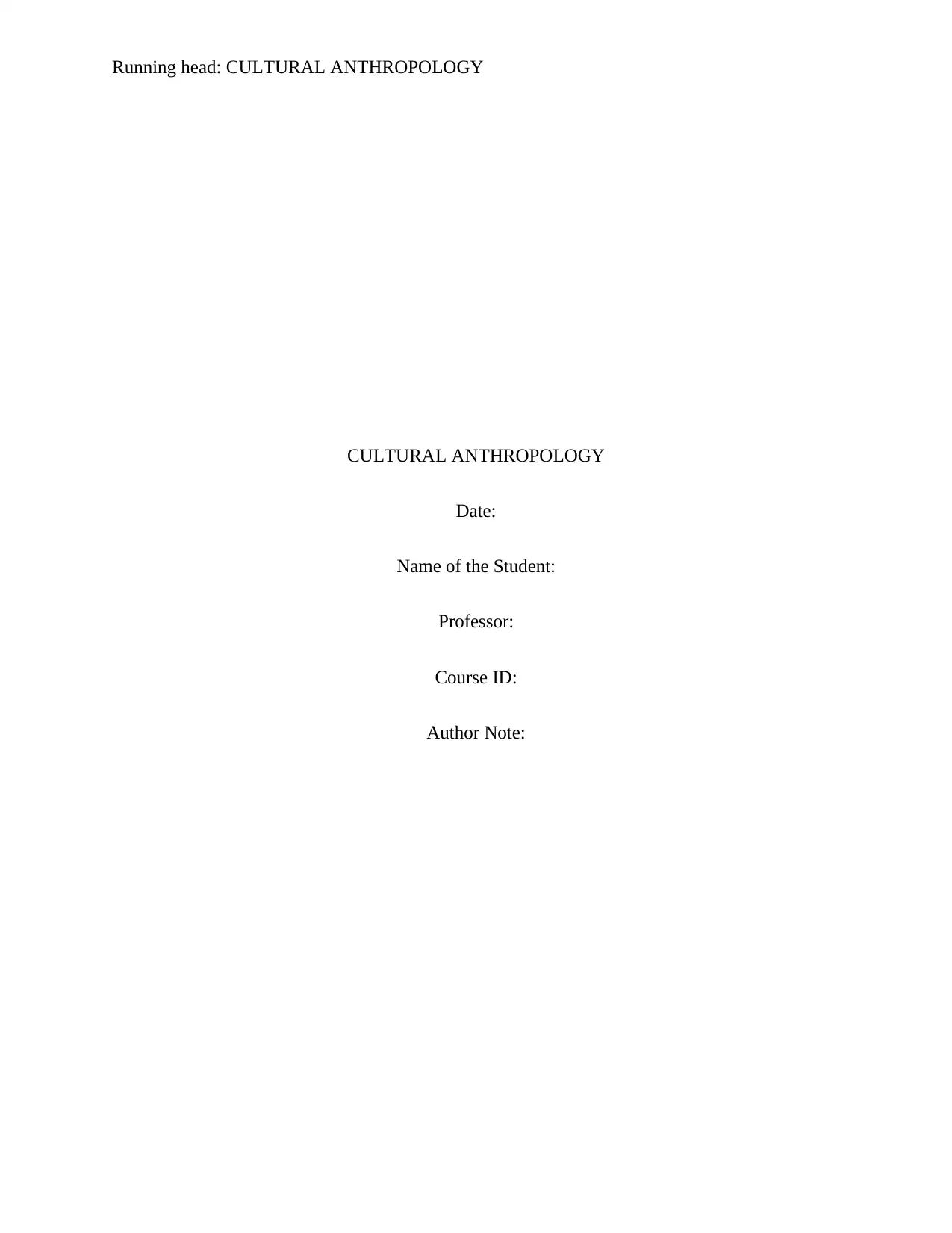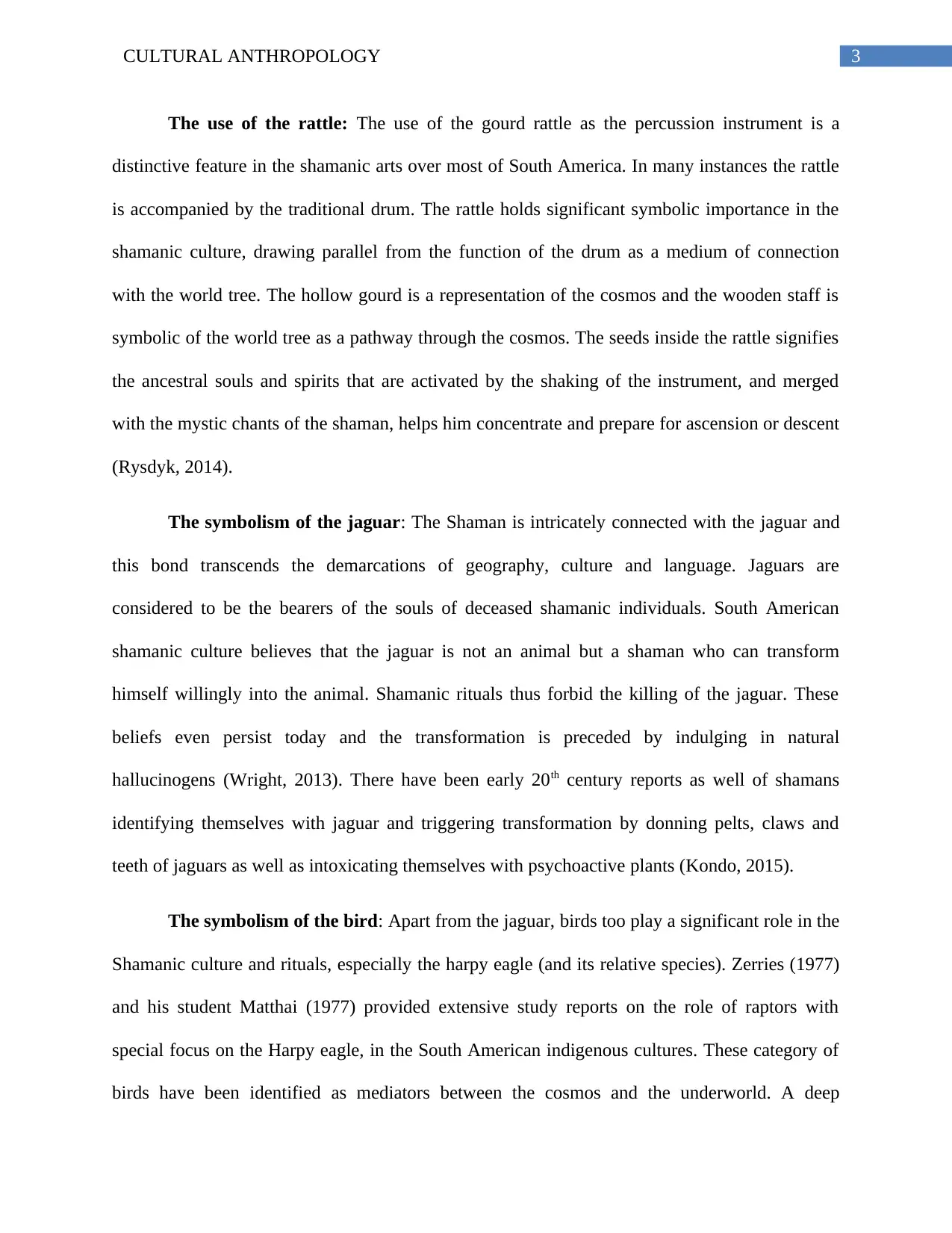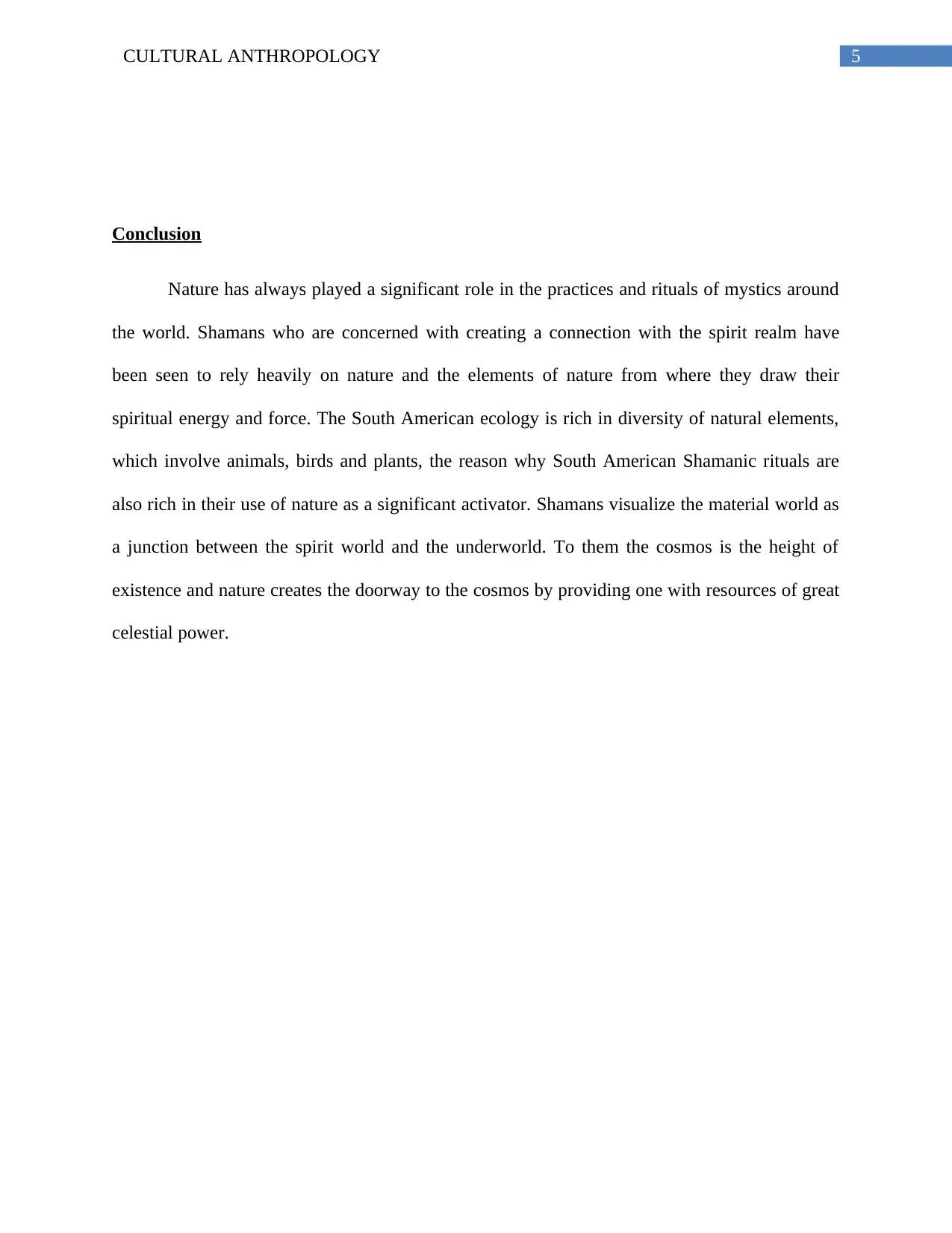A Study of Shamanistic Practices in South American Tribal Cultures
VerifiedAdded on 2022/10/12
|8
|1579
|383
Essay
AI Summary
This essay provides a comprehensive overview of shamanistic practices within the tribal communities of the Amazon rainforest in South America. It delves into the historical context of shamanism, tracing its roots to the earliest migrants of the continent and highlighting the diverse yet interconnected rituals found across various communities. The essay explores key characteristics of South American shamanism, including the use of musical instruments like the gourd rattle and the drum, the significance of jaguar and bird symbolism, and the central role of plant hallucinogens such as ayahuasca. It discusses how these elements contribute to the shamans' ability to connect with the spirit world and facilitate healing and spiritual journeys. The essay emphasizes the deep connection between nature and shamanic practices, showcasing how the rich biodiversity of the South American ecology, including animals, birds, and plants, influences the rituals and beliefs of these communities. The conclusion reinforces the importance of nature as a gateway to the cosmos and a source of spiritual power for shamans.

Running head: CULTURAL ANTHROPOLOGY
CULTURAL ANTHROPOLOGY
Date:
Name of the Student:
Professor:
Course ID:
Author Note:
CULTURAL ANTHROPOLOGY
Date:
Name of the Student:
Professor:
Course ID:
Author Note:
Paraphrase This Document
Need a fresh take? Get an instant paraphrase of this document with our AI Paraphraser

1CULTURAL ANTHROPOLOGY
Abstract
Shamanism is a practice that is generally related to the earth based spiritual systems or
religions based on the veneration of natural phenomena. The rituals and traditions intrinsic to
such belief systems are predominantly headed by the Shaman, a practitioner capable of
transcending this world to interact with the believed spirit world. This paper will discuss the
shamanic traditions seen in the tribal communities of the Amazon rainforest and their ceremonies
and rituals. The focus would be placed on the specific characteristic features that are unique to
the communities’ practices in the continent of South America. They include the use of musical
instruments, hallucinogens, and symbolisms related to the rituals.
Abstract
Shamanism is a practice that is generally related to the earth based spiritual systems or
religions based on the veneration of natural phenomena. The rituals and traditions intrinsic to
such belief systems are predominantly headed by the Shaman, a practitioner capable of
transcending this world to interact with the believed spirit world. This paper will discuss the
shamanic traditions seen in the tribal communities of the Amazon rainforest and their ceremonies
and rituals. The focus would be placed on the specific characteristic features that are unique to
the communities’ practices in the continent of South America. They include the use of musical
instruments, hallucinogens, and symbolisms related to the rituals.

2CULTURAL ANTHROPOLOGY
Introduction
Shamanism is a system of religious practice, where the practitioner or the Shaman is
capable of transcending his physical form on this earth and travelling to the believed spirit world
and then channel that transcendental energy to this world. The practice of shamanism is
generally associated with the indigenous and tribal societies and shamans are believed to possess
the power to heal the sick, communicate with spirits and help souls to pass over to the afterlife
(Drury, 2019). The paper below will discuss the long-standing shamanistic rituals found in the
tribal communities of the Amazon basin and their traditions revolving around them.
Discussion
History of shamanism in South America dates back to the first migrants of the continent.
Shamanism among the Selk’nam (Ona), Yamana (Yaghan) and Halakwip (Alacaluf) of Tiera Del
Fuego on the southernmost edge of the continent are all presumed to have descended from them.
The rituals that exist within the communities across the continent though vary due to outside
influences and internal dynamics, the overall archaic nature of the rituals is common amongst all
the communities, including the high culture of the Andes Mountains. These traits are similar to
the motifs of Siberian and Inuit or Eskimo shamanism, such as mysticism, healing of the sick,
communication with the spirit world and much more. But there are specific traits which have
been moulded by the culture of the South American continent, which differ from the other
existing earth religions (Flaherty, 2014).
According to Johannes Wilbert, his work with the Warao community revealed that their
rituals are actually extremely complex (Johannes, 1974). Some of the characteristic features of
the South American shamanistic rituals are:
Introduction
Shamanism is a system of religious practice, where the practitioner or the Shaman is
capable of transcending his physical form on this earth and travelling to the believed spirit world
and then channel that transcendental energy to this world. The practice of shamanism is
generally associated with the indigenous and tribal societies and shamans are believed to possess
the power to heal the sick, communicate with spirits and help souls to pass over to the afterlife
(Drury, 2019). The paper below will discuss the long-standing shamanistic rituals found in the
tribal communities of the Amazon basin and their traditions revolving around them.
Discussion
History of shamanism in South America dates back to the first migrants of the continent.
Shamanism among the Selk’nam (Ona), Yamana (Yaghan) and Halakwip (Alacaluf) of Tiera Del
Fuego on the southernmost edge of the continent are all presumed to have descended from them.
The rituals that exist within the communities across the continent though vary due to outside
influences and internal dynamics, the overall archaic nature of the rituals is common amongst all
the communities, including the high culture of the Andes Mountains. These traits are similar to
the motifs of Siberian and Inuit or Eskimo shamanism, such as mysticism, healing of the sick,
communication with the spirit world and much more. But there are specific traits which have
been moulded by the culture of the South American continent, which differ from the other
existing earth religions (Flaherty, 2014).
According to Johannes Wilbert, his work with the Warao community revealed that their
rituals are actually extremely complex (Johannes, 1974). Some of the characteristic features of
the South American shamanistic rituals are:
⊘ This is a preview!⊘
Do you want full access?
Subscribe today to unlock all pages.

Trusted by 1+ million students worldwide

3CULTURAL ANTHROPOLOGY
The use of the rattle: The use of the gourd rattle as the percussion instrument is a
distinctive feature in the shamanic arts over most of South America. In many instances the rattle
is accompanied by the traditional drum. The rattle holds significant symbolic importance in the
shamanic culture, drawing parallel from the function of the drum as a medium of connection
with the world tree. The hollow gourd is a representation of the cosmos and the wooden staff is
symbolic of the world tree as a pathway through the cosmos. The seeds inside the rattle signifies
the ancestral souls and spirits that are activated by the shaking of the instrument, and merged
with the mystic chants of the shaman, helps him concentrate and prepare for ascension or descent
(Rysdyk, 2014).
The symbolism of the jaguar: The Shaman is intricately connected with the jaguar and
this bond transcends the demarcations of geography, culture and language. Jaguars are
considered to be the bearers of the souls of deceased shamanic individuals. South American
shamanic culture believes that the jaguar is not an animal but a shaman who can transform
himself willingly into the animal. Shamanic rituals thus forbid the killing of the jaguar. These
beliefs even persist today and the transformation is preceded by indulging in natural
hallucinogens (Wright, 2013). There have been early 20th century reports as well of shamans
identifying themselves with jaguar and triggering transformation by donning pelts, claws and
teeth of jaguars as well as intoxicating themselves with psychoactive plants (Kondo, 2015).
The symbolism of the bird: Apart from the jaguar, birds too play a significant role in the
Shamanic culture and rituals, especially the harpy eagle (and its relative species). Zerries (1977)
and his student Matthai (1977) provided extensive study reports on the role of raptors with
special focus on the Harpy eagle, in the South American indigenous cultures. These category of
birds have been identified as mediators between the cosmos and the underworld. A deep
The use of the rattle: The use of the gourd rattle as the percussion instrument is a
distinctive feature in the shamanic arts over most of South America. In many instances the rattle
is accompanied by the traditional drum. The rattle holds significant symbolic importance in the
shamanic culture, drawing parallel from the function of the drum as a medium of connection
with the world tree. The hollow gourd is a representation of the cosmos and the wooden staff is
symbolic of the world tree as a pathway through the cosmos. The seeds inside the rattle signifies
the ancestral souls and spirits that are activated by the shaking of the instrument, and merged
with the mystic chants of the shaman, helps him concentrate and prepare for ascension or descent
(Rysdyk, 2014).
The symbolism of the jaguar: The Shaman is intricately connected with the jaguar and
this bond transcends the demarcations of geography, culture and language. Jaguars are
considered to be the bearers of the souls of deceased shamanic individuals. South American
shamanic culture believes that the jaguar is not an animal but a shaman who can transform
himself willingly into the animal. Shamanic rituals thus forbid the killing of the jaguar. These
beliefs even persist today and the transformation is preceded by indulging in natural
hallucinogens (Wright, 2013). There have been early 20th century reports as well of shamans
identifying themselves with jaguar and triggering transformation by donning pelts, claws and
teeth of jaguars as well as intoxicating themselves with psychoactive plants (Kondo, 2015).
The symbolism of the bird: Apart from the jaguar, birds too play a significant role in the
Shamanic culture and rituals, especially the harpy eagle (and its relative species). Zerries (1977)
and his student Matthai (1977) provided extensive study reports on the role of raptors with
special focus on the Harpy eagle, in the South American indigenous cultures. These category of
birds have been identified as mediators between the cosmos and the underworld. A deep
Paraphrase This Document
Need a fresh take? Get an instant paraphrase of this document with our AI Paraphraser

4CULTURAL ANTHROPOLOGY
connection with nature can be identified as the plumage of parrots, macaws and other brilliantly
coloured forest birds of the tropics are used for making crowns and prayer sticks. The symbolism
herein expands beyond the shamanic ‘flight’ to that of light influenced by the sun, the moon and
the stars. Here also, psychoactive plants and hallucinogens act as a significant activator that
strengthens the connection between the material and the spiritual realms.
The use of plant hallucinogens: Research says that practically all shamanistic practices
are based on the trance like state induced by potent plant hallucinogens. This decoction has many
names, such as, yage, caapi, or ayahuasca, as known in Quechua spoken in the Andes. It is an
infusion made from the caapi vine. This can also consist of Brugmansia and tobacco juice
(Savin, 2014). Through shamanistic rituals, the South American identified up to two hundred
such hallucinogenic plants. Snuffs were also a big part of the ceremonies. Communities in the
Arawakan valley, Andean mountains, Orinoco delta, coastal Peru dating back to pre-agricultural
inhabitants have been known to use powerful snuff such as the Huilca. It has been deduced that
the ancestors of these communities have essentially valued the visions that these hallucinogens
provided through shamanism. The plant hallucinogens are still in use to the present day. Another
example of ritual intoxication is by the Warao community of Venezuela, studied by Wilbert
(Johannes, 1974). Even though it is not the primary hallucinogen, it is conceptually linked to the
shaman. Such as the Matsigenka term for tobacco is ‘seri and shaman is ‘seripigari’ (Carod-artal,
2015).
connection with nature can be identified as the plumage of parrots, macaws and other brilliantly
coloured forest birds of the tropics are used for making crowns and prayer sticks. The symbolism
herein expands beyond the shamanic ‘flight’ to that of light influenced by the sun, the moon and
the stars. Here also, psychoactive plants and hallucinogens act as a significant activator that
strengthens the connection between the material and the spiritual realms.
The use of plant hallucinogens: Research says that practically all shamanistic practices
are based on the trance like state induced by potent plant hallucinogens. This decoction has many
names, such as, yage, caapi, or ayahuasca, as known in Quechua spoken in the Andes. It is an
infusion made from the caapi vine. This can also consist of Brugmansia and tobacco juice
(Savin, 2014). Through shamanistic rituals, the South American identified up to two hundred
such hallucinogenic plants. Snuffs were also a big part of the ceremonies. Communities in the
Arawakan valley, Andean mountains, Orinoco delta, coastal Peru dating back to pre-agricultural
inhabitants have been known to use powerful snuff such as the Huilca. It has been deduced that
the ancestors of these communities have essentially valued the visions that these hallucinogens
provided through shamanism. The plant hallucinogens are still in use to the present day. Another
example of ritual intoxication is by the Warao community of Venezuela, studied by Wilbert
(Johannes, 1974). Even though it is not the primary hallucinogen, it is conceptually linked to the
shaman. Such as the Matsigenka term for tobacco is ‘seri and shaman is ‘seripigari’ (Carod-artal,
2015).

5CULTURAL ANTHROPOLOGY
Conclusion
Nature has always played a significant role in the practices and rituals of mystics around
the world. Shamans who are concerned with creating a connection with the spirit realm have
been seen to rely heavily on nature and the elements of nature from where they draw their
spiritual energy and force. The South American ecology is rich in diversity of natural elements,
which involve animals, birds and plants, the reason why South American Shamanic rituals are
also rich in their use of nature as a significant activator. Shamans visualize the material world as
a junction between the spirit world and the underworld. To them the cosmos is the height of
existence and nature creates the doorway to the cosmos by providing one with resources of great
celestial power.
Conclusion
Nature has always played a significant role in the practices and rituals of mystics around
the world. Shamans who are concerned with creating a connection with the spirit realm have
been seen to rely heavily on nature and the elements of nature from where they draw their
spiritual energy and force. The South American ecology is rich in diversity of natural elements,
which involve animals, birds and plants, the reason why South American Shamanic rituals are
also rich in their use of nature as a significant activator. Shamans visualize the material world as
a junction between the spirit world and the underworld. To them the cosmos is the height of
existence and nature creates the doorway to the cosmos by providing one with resources of great
celestial power.
⊘ This is a preview!⊘
Do you want full access?
Subscribe today to unlock all pages.

Trusted by 1+ million students worldwide

6CULTURAL ANTHROPOLOGY
Bibliography
Carod-Artal, F. J. (2015). Hallucinogenic drugs in pre-Columbian Mesoamerican
cultures. Neurología (English Edition), 30(1), 42-49.
Drury, N. (2019). The Shaman and the Magician: Journey's Between the Worlds. Routledge.
Flaherty, G. (2014). Shamanism and the eighteenth century (Vol. 190). Princeton University
Press.
Johannes, W. (1973–1974): The Calabash of the Ruffled Feathers. Artscanada 30: 90–93
Kondo, H. (2015). The Skin as a Surface of Composition: The Use of Animal Body Parts and
Plants in Various Practices of the Panamanian Emberá. Tipití: Journal of the Society
for the Anthropology of Lowland South America, 13(2), 11-24.
Matthäi, H. (1977). Die Rolle der Greifvögel, insbesondere der Harpye und des
Königsgeiers, bei ausserandinen Indianern Südamerikas (Vol. 1). Renner.
Rysdyk, E. C. (2014). A Spirit Walker's Guide to Shamanic Tools: How to Make and Use
Drums, Masks, Rattles, and Other Sacred Implements. Weiser Books.
Sayin, H. U. (2014). The Consumption of Psychoactive Plants During Religious Rituals: The
Roots of Common Symbols and Figures in Religions and
Myths. NeuroQuantology, 12(2).
Wright, R. M. (2013). Mysteries of the jaguar shamans of the Northwest Amazon. U of
Nebraska Press.
Zerries, O. (1962). Die Vorstellung vom zweiten Ich und die Rolle der Harpye in der Kultur
der Naturvölker Südamerikas. Anthropos, (H. 3./6), 889-914.
Bibliography
Carod-Artal, F. J. (2015). Hallucinogenic drugs in pre-Columbian Mesoamerican
cultures. Neurología (English Edition), 30(1), 42-49.
Drury, N. (2019). The Shaman and the Magician: Journey's Between the Worlds. Routledge.
Flaherty, G. (2014). Shamanism and the eighteenth century (Vol. 190). Princeton University
Press.
Johannes, W. (1973–1974): The Calabash of the Ruffled Feathers. Artscanada 30: 90–93
Kondo, H. (2015). The Skin as a Surface of Composition: The Use of Animal Body Parts and
Plants in Various Practices of the Panamanian Emberá. Tipití: Journal of the Society
for the Anthropology of Lowland South America, 13(2), 11-24.
Matthäi, H. (1977). Die Rolle der Greifvögel, insbesondere der Harpye und des
Königsgeiers, bei ausserandinen Indianern Südamerikas (Vol. 1). Renner.
Rysdyk, E. C. (2014). A Spirit Walker's Guide to Shamanic Tools: How to Make and Use
Drums, Masks, Rattles, and Other Sacred Implements. Weiser Books.
Sayin, H. U. (2014). The Consumption of Psychoactive Plants During Religious Rituals: The
Roots of Common Symbols and Figures in Religions and
Myths. NeuroQuantology, 12(2).
Wright, R. M. (2013). Mysteries of the jaguar shamans of the Northwest Amazon. U of
Nebraska Press.
Zerries, O. (1962). Die Vorstellung vom zweiten Ich und die Rolle der Harpye in der Kultur
der Naturvölker Südamerikas. Anthropos, (H. 3./6), 889-914.
Paraphrase This Document
Need a fresh take? Get an instant paraphrase of this document with our AI Paraphraser

7CULTURAL ANTHROPOLOGY
1 out of 8
Your All-in-One AI-Powered Toolkit for Academic Success.
+13062052269
info@desklib.com
Available 24*7 on WhatsApp / Email
![[object Object]](/_next/static/media/star-bottom.7253800d.svg)
Unlock your academic potential
Copyright © 2020–2025 A2Z Services. All Rights Reserved. Developed and managed by ZUCOL.